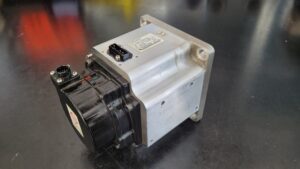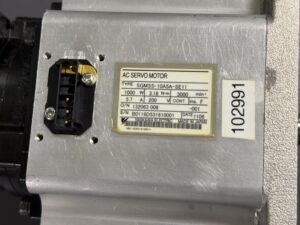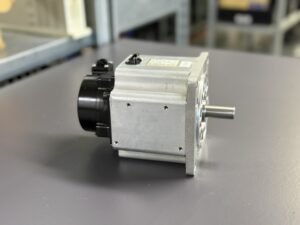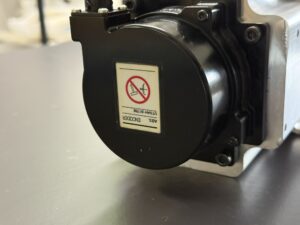30.10.2025 by Viktor Siebert
Repair of a Yaskawa SGMSS-10A5A-SE11 AC Servo Motors with Encoder Damage Due to Coolant Ingress
The Yaskawa AC servo motor SGMSS-10A5A-SE11 belongs to the compact, high-performance SGMSS series, frequently used in Siemens/Yaskawa CNC control systems. With a rated output of 1 kW, a nominal torque of 3.18 N·m, and a rated speed of 3000 rpm, this motor is designed for precise axis movements in high-accuracy machine tools. The system is operated with a Yaskawa SGDK-101010AEA-VY24 servopack, which is specifically configured for this drive combination.
Error Description and Damage Analysis
The motor was received with the fault message “Encoder Error.” During the initial inspection, it was immediately noticeable that the motor was heavily contaminated, especially in the encoder area. After disassembly, it became clear that a coolant mixture had penetrated into the encoder housing. Over time, this fluid caused severe corrosion and mechanical damage: the encoder ball bearings had seized completely, preventing the encoder disk from rotating freely. As a result of this mechanical blockage, the sensitive glass disk inside the encoder was scratched and cracked, leading to complete signal failure.
The root cause was traced to a damaged seal at the connection point between the motor and encoder. The sealing ring had lost its elasticity, likely due to the chemical influence of coolant and years of thermal stress. This type of failure typically occurs in machines operated in humid or coolant-laden environments without adequate sealing at the rear motor section.
Technical Diagnosis and Testing Procedure
After cleaning and drying, both the stator windings and the encoder connections were electrically tested. The insulation resistance was within acceptable range, but the encoder feedback produced no valid sine/cosine signal. When connected to the SGDK servopack, the display showed fault code 0x63 (“Error with pulse count per rotation when encoder is used”).
This confirmed a loss of pulse feedback or defective signal generation, caused by the damaged optical disk and the mechanical seizure of the encoder bearings.
Complete disassembly of the encoder verified this hypothesis: rust particles, dried coolant residue, and destroyed seals had contaminated the entire interior. A repair of the original encoder was neither technically nor economically feasible. Therefore, a new UTSAH-B17BE encoder was installed and precisely aligned with the motor shaft using an optical reference system.
Repair Process and Calibration
The repair process consisted of the following steps:
- Mechanical rework: Cleaning of all housing parts, removal of corrosion residue, and verification of mounting surfaces.
- Seal replacement: All rubber and silicone seals were replaced with new, coolant-resistant variants.
- Encoder replacement: Installation of a new UTSAH-B17BE encoder, including zero-position alignment via optical calibration.
- Bearing inspection: Checking of main bearings for play and noise, replacement as a preventive measure if necessary.
- Final testing: Full functional verification on the Yaskawa SGDK-101010AEA-VY24 test bench, including torque, positioning, and feedback stability tests.
After successful calibration, the new encoder delivered a clean and stable sine/cosine feedback signal. All position tests were passed, and the motor completed the full test cycle without any further alarms.
Preventive Measures
To prevent similar failures in the future, the following preventive steps are recommended:
- Regular inspection of the motor rear section: Especially on machines exposed to coolant or emulsions, check the connector area for moisture.
- Use of additional protective covers or sealing hoods in coolant-intensive environments.
- Drying and cleaning after production downtime to remove residual moisture near the encoder.
- Installation of corrosion-resistant replacement components during overhaul or reinstallation.
These preventive measures significantly increase motor lifetime and ensure stable encoder feedback quality over the long term.
Conclusion
The case of the Yaskawa SGMSS-10A5A-SE11 clearly demonstrates how sensitive the interface between mechanics and electronics can be in modern servo systems. Even minimal amounts of penetrating fluid can cause severe damage to the feedback electronics. Thanks to our specialized Yaskawa/Siemens test stands and experience, the motor was fully restored and successfully commissioned. After repair, it once again delivered full performance at 3000 rpm and 3.18 N·m torque.
Through thorough diagnostics, preventive sealing, and precise calibration, not only was the function restored, but the reliability of the entire drive system was also ensured for long-term operation.







Information about the mentioned Servopack and Servomotor:
More information about our Yaskawa repairs can be found here.
📞 Feel free to contact us if you have any questions regarding your Yaskawa drive technology. Our experienced team is always ready to assist you.
Technical Data of the AC Servo Motor
| Specification | Description |
|---|
| Manufacturer | Yaskawa Electric Corporation |
| Model | SGMSS-10A5A-SE11 |
| Category | AC Servo Motor |
| Series | SGMSS (Sigma II, compact type) |
| Rated Power | 1000 W (1 kW) |
| Rated Torque | 3.18 N·m |
| Rated Current | 5.7 A |
| Rated Voltage | 200 V AC |
| Rated Speed | 3000 rpm |
| Insulation Class | F |
| Encoder Type | UTSAH-B17BE (17-bit absolute optical encoder) |
| Protection Class | IP65 (with intact encoder seal) |
| Connection Type | 4-pin power + 13-pin encoder connector |
| Cooling Method | Natural convection / flange conduction |
| Compatible Servopack | Yaskawa SGDK-101010AEA-VY24 |
| Brake Type | Without integrated brake |
| Weight | Approx. 3.8 kg |
| Country of Origin | Japan |
| Serial Number (Example) | B0116D531610001 |
| Manufacturing Period | 2006 – 2011 (depending on serial number) |
Special Features
- OEM configuration for Siemens/Yaskawa combined control systems.
- High positioning accuracy via precise sine/cosine encoder feedback.
- Compact design ideal for confined installation spaces.
- Sensitive to fluid ingress at the encoder mounting flange.
Typical Alarms – Yaskawa SGDK / SGMSS Combination
| Code | Name | Description / Cause | Corrective Action |
|---|
| 0x61 | C-phase signal detection failure | Encoder C-phase signal missing or unstable | Check encoder, clean cable connectors |
| 0x63 | Error with pulse count per rotation (encoder used) | Missing sine/cosine feedback, damaged or blocked encoder | Clean or replace encoder, check alignment |
| 0x64 | Position-detecting signal wire break | Open circuit in feedback line | Inspect wiring and connectors |
| 0x65 | INC signal error (encoder used) | Incomplete or distorted incremental feedback | Test encoder output, replace if needed |
| 0x66 | Magnet sensor signal error | Applies only to magnetic feedback encoders | Not relevant for UTSAH encoder |
| 0x6A | Magnet sensor wire break | Broken wire or disconnection | Replace cable |
| 0x79 | Motor overheat | Excessive load, cooling failure, ambient temperature too high | Improve cooling, check load |
| 0x7B | Fin temperature rise for more than 1 minute | Continuous overload, insufficient cooling | Check airflow and ventilation |
| 0x81 | PG backup error | Feedback memory or battery error | Check encoder battery and connection |
| 0xC3 | Wire break in pulse encoder A/B-phase | Broken signal line or damaged glass disk | Replace encoder |
| 0xC4 | Wire break in pulse encoder C-phase | Optical disk or photodiode failure | Replace encoder |
| 0xC5 | Motor magnetic pole detection error | Improper synchronization during initialization | Adjust motor parameters and encoder alignment |
| 0xC6 | PG wire break (PA/PB) | Damaged or oxidized feedback cable | Inspect and clean connections |
| 0xEA | No drive response | Disconnection between servopack and motor | Check cable and motor connection |
| 0xF4 | Low voltage | DC bus or power input below threshold | Check power supply and capacitors |